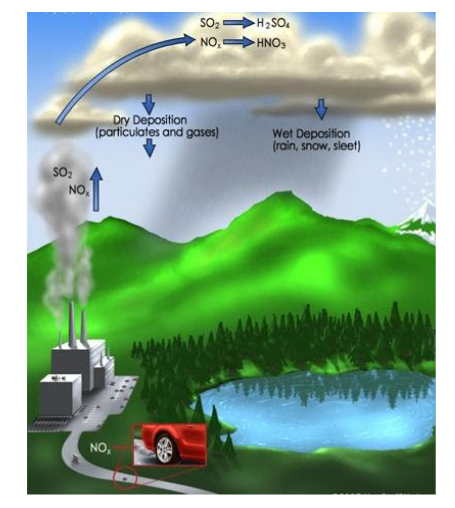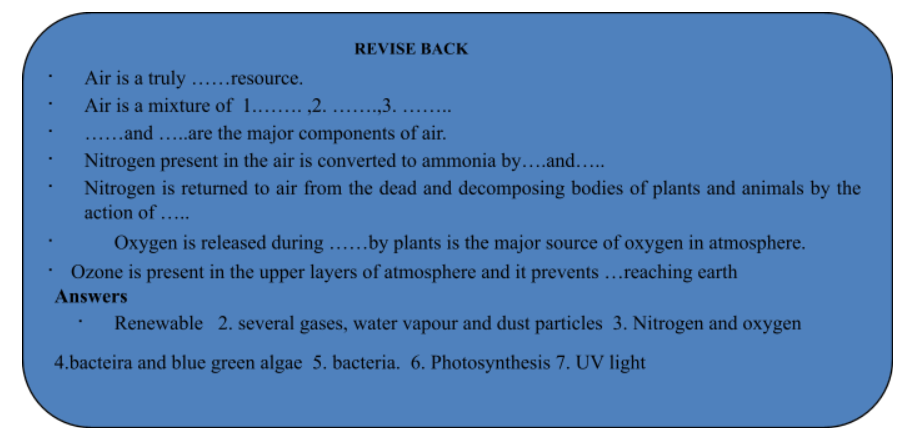
POLLUTION
Natural resource of Class 9
AIR OR ATMOSPHERE:
Air is an important form of inexhaustible natural resource which is essential for our survival. In a world without air, there would be no plant or animal life; no fire as burning needs oxygen; no protection from harmful solar radiation; and great temperature variation (from about 110° C at day time to about – 184°C at night).
Composition of Air:
|
Component |
Volume |
|
Nitrogen (N 2 ) Oxygen (O 2 ) Carbon dioxide (CO 2 ) Argon Trace components* |
78.08% 20.92% 0.03%** 0.93% 0.04% |
Besides these gaseous components air also possesses water vapour, industrial gases, dust, smoke particles, microorganisms, pollen grains, fungal spores etc.
Different Regions of Atmosphere
Region Range of distance Density of Air Importance
Troposphere 10–12 kms from the Highest Most of the atmospheric air is present
surface of earth here. It is a medium for locomotion of flying animals, helps in dispersal of seeds and fruits; region of cloud formation.
Stratosphere 12–60 kms Less than Contains ozone layer that traps most
troposphere of UV rays and cosmic rays of the sun.
Mesosphere 60–100 kms Low —
Thermosphere 100 kms upwards Extremely low Reflect radio waves back to earth, artificial satellites are present here.
At a height between 15 kms and 60 kms, there is a layer of ozone gas in the upper atmosphere. This ozone layer is very important for the existence of life on earth. This is because ozone layer absorbs most of the harmful UV radiations coming from the sun which can otherwise cause inflammatory diseases, skin cancer, cataract etc. A normal human being requires about 250 to 265 kg air per day for performing various activities.
Importance of Air
Air is essential for the survival and continuity of life as its constituents are needed for various biological processes.
Role of Gases
The various gases present in the air have different functions. They are:
- Respiration: The correct proportions of nitrogen and oxygen are required for respiration. In the cell, the oxygen oxidizes sugar molecules to produce carbondioxide and water, and liberates energy. The carbon dioxide is expelled out and the energy is used to perform various activities.
- Burning: The oxygen of air is essentially required for burning of things like wood, fuels, organic wastes, etc. When they burn in air, carbondioxide and water vapour are produced with the release of heat energy.
- Forest fire: It consumes a lot of oxygen.
- Photosynthesis: Green plants convert carbondioxide to glucose in the presence of sunlight.

- Formation of shells: Many marine animals use carbonates dissolved in sea water to form their shells.
The role of air in climate control
Air is a bad conductor of heat. The atmosphere (envelope of air) acts as a protective blanket for living organisms in the following ways:
- Air plays a very important role in keeping the temperature of the Earth fairly steady during the day and even during the course of whole year. This happens as a result of a phenomenon known as the green house effect.
- Certain gases like carbon dioxide, methane, etc. called green house gases prevent the sudden increase in temperature during the day and slows down the escape of heat during the night. The situation on the moon is quite different which is about the same distance from the sun as the Earth. Moon has no atmosphere and the temperature ranges from – 190°C to 110°C.
THE MOVEMENT OF AIR WIND:
All the places on Earth are not equally heated up by the sun. When a place becomes heated, the surrounding air also becomes warm. The warm air, being lighter, rises up. A low pressure area is created there. The cold air from the cooler and high pressure regions then moves in to take its place. This movement of air takes place due to uneven heating of different places on the Earth. Due to the unequal heating of places, convection currents are produced in the air. When air moves horizontally, it is called wind. Water vapours are formed due to the heating of water bodies by solar radiations as well as the activities of living organisms.The phenomena like movement of air (whether the movement of air will be in the form of a gentle breeze, a strong wind or a terrible storm) and the rain are the result of changes that take place in our atmosphere due to the uneven heating of air and the formation of water vapours. However, couples of other factors like the rotation of Earth, the presence of mountain ranges in the path of the winds also influence.
Air in called wind. Speed of wind can be determined by:
- Heating of air
- Formation of water vapour
Factors controlling movement of air
- Rotation of earth.
- In the path of wind, mountain ranges may come across. The general pattern of winds over earth is known as general circulation and specific winds are named for the direction from which they originate (e.g. wind blowing from west to east is westerly). Wind speeds are often classified according to Beaufort scale.
SEA BREEZE AND LAND BREEZE:
During the daytime, the air above the land gets heated faster than water. Hot air above land rises creating a low pressure area and air from the sea moves into this area. Thus, movement of air takes place from the sea side to the land side. This is called sea breeze. During night, both the land and the sea start cooling. But the cooling of sea takes place at a slower rate than that of the land. Thus, a low pressure area is created in the sea. The air then moves from the land to the sea. This is called land breeze.
These breezes always occur in the coastal areas.

Movement of wind from sea to land during day and from land to
sea during night in coastal areas.
Clouds and rain (Condensation and precipitation of water vapour)
Air always contains some amount of water vapour at a given temperature. When the temperature of air falls below a certain temperature, the excess water vapour present in the air gets transformed into tiny droplets of water. This process is called condensation. The temperature at which condensation takes place is called the dew point. A surface called nucleus is required for the condensation to take place. Dust particles, tree leaves, grass, etc. are examples of nuclei.
During the day, a large amount of water vapour goes to air which then rises up, expands and gets cooled. When the temperature falls below the dew point, the excess of water present in the air gets condensed around the dust particles forming tiny droplets of water. When the temperature drops further, these droplets get condensed into tiny crystals of ice which being light floats in the sky. Millions of such droplets come together to form larger droplets called clouds. When these droplets become big enough and heavy, they cannot stay in the air. They come down on Earth as rain.
Patterns of rainfall of an area or region are determined by the prevailing wind patterns. In large parts of our country, rains are mostly brought by the south-west monsoons and to a smaller extent by north-east monsoons.
POLLUTION:
- Any undesirable change in physical, chemical or biological characteristics in the air, water
- and land which is harmful to the men directly or indirectly though animals, plants,
- industrial units or raw materials is called as pollution. Pollution is mostly man made. But
- it can also be natural.
Pollutants :
Any material or act of man, or nature which leads to pollution is called as pollutants. The pollution is usually brought about by the addition to the environment of waste products of human activity. When the waste products are not efficiently assimilated, decomposed or other wish removed by natural, biological and physical processes (recycling) and the system is unable to utilize them properly, so that the balance of the system breaks down. Therefore such type of pollutants can stimulate or inhibit the biological reactions or change in their capacity. Therefore changes also take place in the ecosystem. The amount, numbers and types of pollutants are increasing with the growth of the population.
Air Pollution :
Air pollution is caused due to the addition of the unwanted substances or gases. The atmospheric pollution is mainly caused by the activities of man and concentrated to the inhabited and the industrial complexes in cities. There are two main categories of air pollutants.
- Gaseous: The gaseous materials include various gases and vapours of volatile substances or the compound with a boiling point below 200 0 C.
- Particulate: Dust particles, carbon particles, particles of other matels etc.
Major air Pollutants and Their Effects :
- Carbon monoxide (CO): this is the main air pollutant. Carbon monoxide is a highly toxic as which is colourless and odourless in nature. It combines with hemoglobin of the blood and blocks the transportation of oxygen. Thus, it impairs respiration and it causes death.
- Unburnt hydrocarbons: Out of them 3, 4 – benzpyrene is the main pollutant. This causes cancer in lungs.
- Ethylene: The falling of leaves without particular reason, falling buds et. Effects are seen in plants are due to ethylene.
- Oxides of nitrogen: these oxides form photochemical smog in the atmosphere and release ozone. Ozone causes harm to mucilaginous membrane. The oxide pollutants of nitrogen are nitric oxide (NO), and nitrogen di oxide (NO 2 ). These oxides and ozone are very harmful for the plants. The entry of these pollutants causes various diseases in animals like- respiratory trouble such as emphysema, bronchitis, swelling of lungs and lung cancer etc.
- Smoke : Many constituents are present in smoke such as sulphur dioxide(SO 2 ), Sulphur trioxide (SO 3 ), Sulphuric acid (H 2 SO 4 ), Ozone (O 3 ), Carbon dioxide (CO 2 ), PAN (Peroxyacetyle nitrate), Arsenic and Fluoride etc. the distribution area of lichen and mosses are the indicators of SO 2 pollution because lichen and mosses cannot grow in the industrial regions or the regions containing SO 2 pollutants. The higher concentration of ozone produces harmful effects. But normally, ozone layer absorbs U.V. rays which are harmful for the living things.
- Aerosol: The aerosol like C.F.C. (chlorofluoro carbon) release into the atmosphere from the refrigerators, air conditioners and jet planes deplete or reduce the ozone layer. This thin layer of ozone is also known as ozone hole results in the increase in temperature of the earth.

Acid rain
Measures to Control Air Pollution :
- Barium compounds should be mixed with petrol which reduce the smoke.
- It is also very essential to check the quality of gases released from the factories.
- Industries should not be established at one place.
- The smoke should be released into the atmosphere after filtration and purification (by cyclone collector or electrostatic precipitators).





